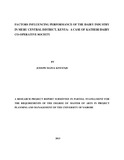| dc.description.abstract | The Kenya vision 2030 is the country’s new development blueprint aiming at transforming the country into a newly industrializing, middle income country providing a high quality life to all its citizens by the year 2030. The vision is based on three pillars; the economic, the social and the political. The dairy industry contributes towards the economic pillar and in view of this the Ministry of Livestock Development (2010) developed the National Dairy Master Plan with a focus on realizing the vision 2030. The overriding development goal is to make Kenya a globally competitive prosperous nation with a high quality life by the year 2030 through strategies aimed at enhancing food security and sustainable economic development. To realize this vision, the revitalization of the agricultural sector remains a prerequisite condition for achieving food security, economic recovery, economic growth, employment and wealth creation. This is, therefore, crucial in achieving the twin Millennium Development Goals of reducing poverty and reducing hunger in Kenya by the year 2015. The study therefore, intended to investigate factors influencing performance of the dairy industry in Meru Central District, Kenya, through the following objectives; evaluating the quality of breeds, assessing the types of animal feeds, identifying how milk cold chains and how milk marketing influence performance of the dairy industry in Meru Central District in order to make a contribution to vision 2030 and the Millennium Development Goals. The study used a descriptive survey design. The use of questionnaires was used as the instrument for this study. Data collection was done though simple random sampling from the 3,400 registered dairy farmers in Katheri Dairy Cooperative Society where a sample population size of 204 respondents was targeted for the study. Pretesting of data collection instrument was done to prove validity of the instrument. The collected data was cleaned, coded and analyzed using Statistical Package of Social Sciences and results presented in tables and percentages. The study found out that Friesian was the highly reared cattle breed and that majority of the dairy farmers were milking only one cow. On type of feeds, the study found out that the farmers fed their animals using natural grass and dairy meal. It was also established that the dairy farmers sold the milk immediately to avoid spoilage and that those who were near a milk cooling facility enabled them sell milk from the evening milking. The study established that the farmers preferred using brokers/middlemen to market their milk and that dairy farming was profitable. The research findings are important to the dairy farmers, milk processors, milk market players, Ministry of Livestock Development, Ministry of Cooperatives Development and policy makers. | en |

